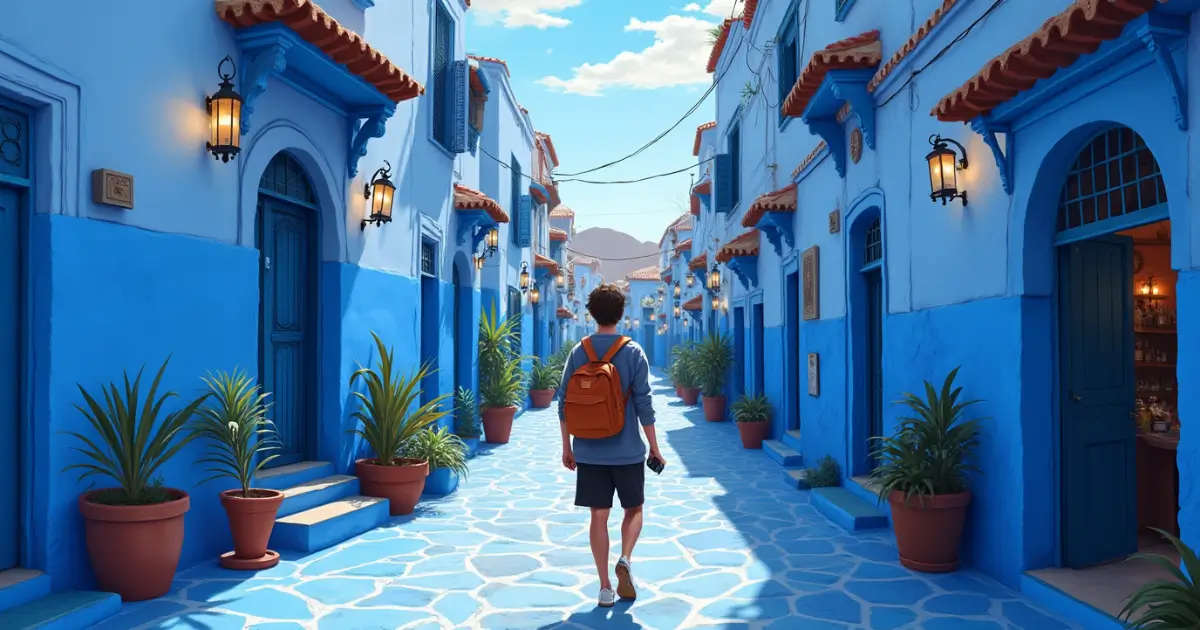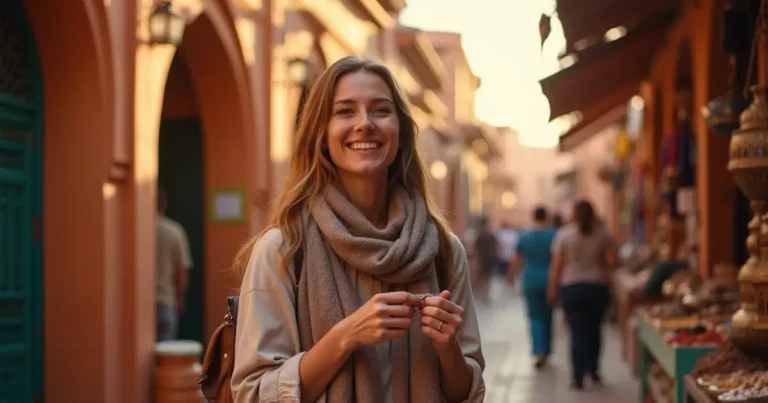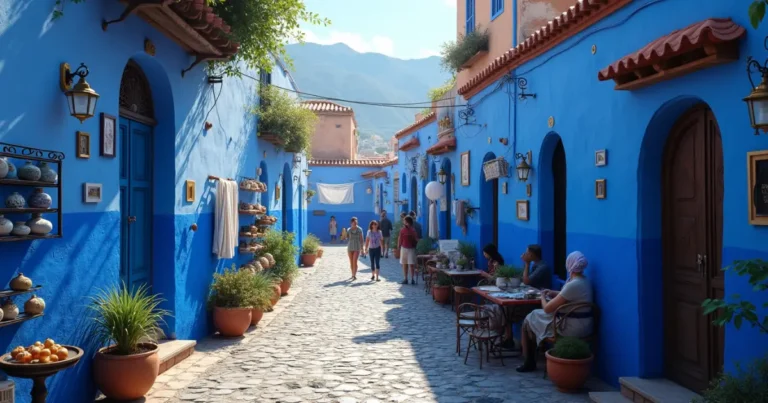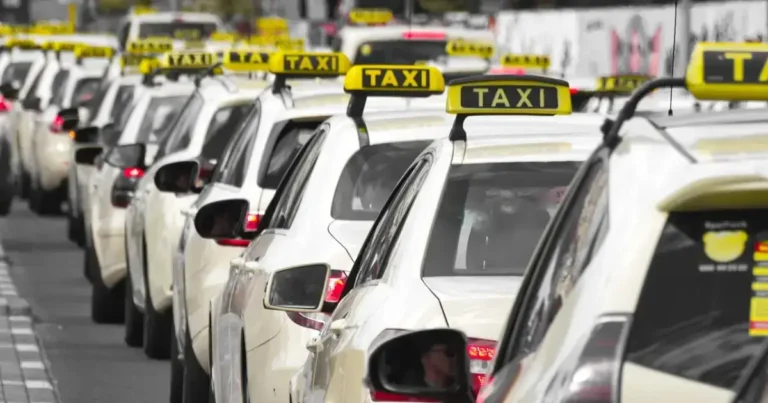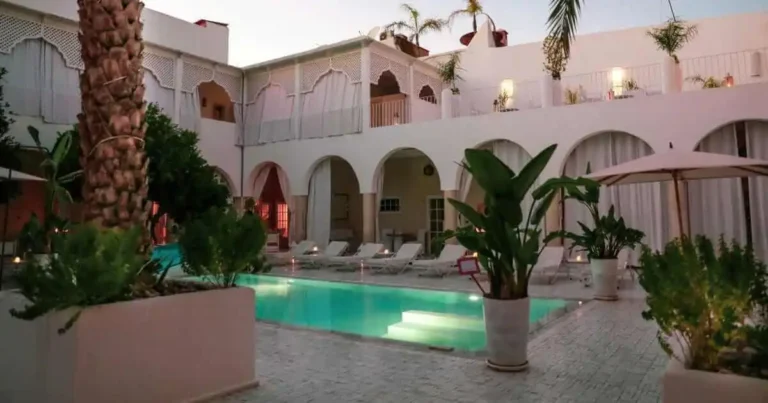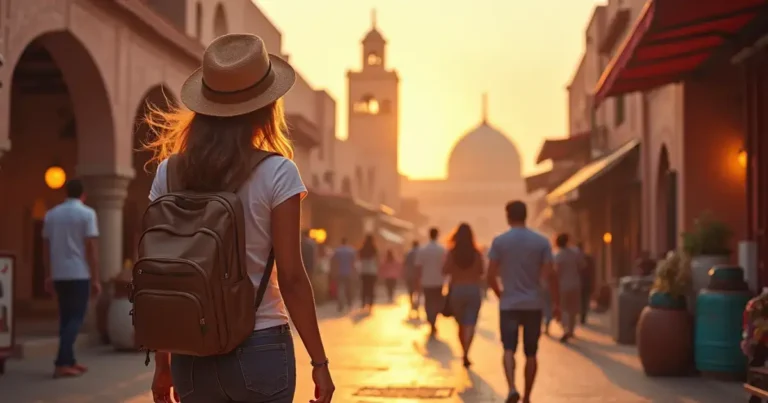The Solo Traveler’s Guide to Chefchaouen, Morocco
Introduction
Did you know that over 78% of solo travelers report having more authentic cultural experiences compared to those traveling in groups? Nestled in Morocco’s Rif Mountains, the enchanting blue city of Chefchaouen offers precisely this kind of immersive adventure. This comprehensive guide to Chefchaouen will walk you through everything you need to know about exploring this mesmerizing destination on your own. From its stunning azure alleyways to the surrounding natural wonders, Chefchaouen combines cultural richness with breathtaking scenery, making it an ideal destination for the independent explorer seeking both tranquility and adventure.
Whether you’re drawn to the photogenic blue-washed medina, the nearby hiking trails, or the distinctive local crafts, this guide will help you navigate Chefchaouen like a seasoned traveler. Let’s dive into the blue pearl of Morocco and discover why it deserves a prime spot on your solo travel itinerary.
Top Attractions to Visit
Chefchaouen’s allure extends far beyond its famous blue streets. Here are the must-visit attractions that should be on every solo traveler’s list:
Medina (Old Town)
The heart of Chefchaouen and its most famous feature, the blue-washed medina, is a photographer’s paradise and a wanderer’s delight. The varying shades of blue that coat the buildings create an otherworldly atmosphere as you navigate the winding alleyways. The tradition of painting buildings blue dates back to the 15th century when Jewish refugees brought this practice, believing blue represented the sky and heaven. Take your time exploring the hidden corners, where each turn reveals charming doorways, colorful potted plants, and local artisans at work.
Plaza Uta el-Hammam
This central square serves as the bustling hub of Chefchaouen. Lined with cafes and restaurants, it’s the perfect place to people-watch while sipping on mint tea. The square is dominated by the Grand Mosque and the kasbah, creating a picturesque backdrop for a relaxing afternoon. The atmosphere changes throughout the day – quiet and serene in the morning, lively and vibrant by evening.
Kasbah Museum
The restored kasbah in the center of town houses a small but fascinating museum showcasing Chefchaouen’s history and culture. Its distinctive octagonal tower offers panoramic views over the city and surrounding mountains. Inside, you’ll find exhibits on local crafts, historical artifacts, and traditional clothing. The peaceful Andalusian gardens within the kasbah provide a refreshing respite from exploration.
Ras El-Ma (Head of the Water)
At the eastern edge of the medina lies Ras El-Ma, a picturesque waterfall where local women traditionally wash their clothes. The sound of rushing water creates a soothing soundtrack as you observe daily life unfolding. Follow the path alongside the water to reach a small bridge offering exceptional views of the city. It’s particularly magical during sunset when the blue city glows in the golden light.
Spanish Mosque
Perched on a hill overlooking Chefchaouen, the abandoned Spanish Mosque is reached via a 30-minute hike from the eastern gate of the medina. Built in the 1920s during the Spanish occupation but never used, it now serves as the premier viewpoint for sunset admirers. The panoramic vistas of Chefchaouen nestled in the mountainside are absolutely worth the uphill journey.
Talassemtane National Park
Just 30 minutes from the blue city, this natural wonderland offers hiking opportunities through cedar and fir forests. The park is home to the rare Barbary macaque and various bird species. The Akchour area within the park features the stunning God’s Bridge natural rock formation and refreshing waterfalls perfect for a cooling dip during summer months.
Kashba Wine and Cheese Shop
A hidden gem unknown to most tourists, this charming little shop offers local goat cheeses paired with Moroccan wines. The friendly owner provides generous samples and stories about local food production, making this a delightful sensory experience for culinary enthusiasts.
Best Time to Visit
Timing your visit to Chefchaouen can significantly impact your experience. Here’s a seasonal breakdown to help you plan the perfect trip:
Spring (March to May)
Statistically, spring is considered the optimal time to visit Chefchaouen, with average temperatures ranging from 59°F to 77°F (15°C to 25°C). The surrounding landscapes burst with wildflowers, creating stunning contrast against the blue buildings. April sees approximately 50% fewer tourists than summer months while offering comfortable exploring weather and vibrant seasonal colors.
Summer (June to August)
Summer brings warmer temperatures, averaging 77°F to 95°F (25°C to 35°C), and the highest tourist numbers. Data from local tourism boards shows visitor numbers increase by approximately 65% compared to other seasons. While the heat can make midday exploration challenging, the extended daylight hours allow for early morning and evening adventures when temperatures are more pleasant.
Fall (September to November)
Fall offers a sweet spot of mild weather (59°F to 77°F/15°C to 25°C) and thinning crowds (approximately 40% fewer visitors than summer). The light in autumn creates a particularly photogenic atmosphere, with the blue buildings seeming more vivid against the autumn sky. October specifically offers an excellent balance of pleasant climate and moderate tourist density.
Winter (December to February)
Winter brings cooler temperatures ranging from 41°F to 59°F (5°C to 15°C) and occasional rainfall. Tourist numbers drop by up to 70% compared to peak season, resulting in significantly lower accommodation prices (often 30-40% less). While some days might be chilly, winter offers a unique opportunity to experience Chefchaouen like a local, with atmospheric mist often shrouding the blue city in the mornings.
Crowd Insight: Regardless of season, Chefchaouen tends to get more crowded on weekends when domestic tourists visit from Moroccan cities. Planning your stay during weekdays can result in a more relaxed experience.
Step-by-Step Travel Itinerary
Day 1: Arrival and First Impressions
Morning: Begin your Chefchaouen adventure by arriving from Tangier (2-hour drive) or Fes (3.5-hour drive). Check into your accommodation – consider a traditional riad within the medina for an authentic experience. Café Clock or Populaire Saveur de Poisson make excellent spots for a light lunch to fuel your exploration.
Afternoon: Take a gentle orientation walk through the blue alleyways of the medina. Don’t follow a specific route – the joy of Chefchaouen is in getting pleasantly lost among the azure passages. Eventually make your way to Plaza Uta el-Hammam to people-watch at a café.
Evening: Watch the sunset from the Spanish Mosque viewpoint (depart 45 minutes before sunset). For dinner, try Restaurant Beldi Bab Ssour for traditional Moroccan cuisine with mountain views.
Day 2: Cultural Immersion
Morning: Start early to witness locals beginning their day and to photograph the blue streets in soft morning light. Visit the Kasbah Museum when it opens to avoid crowds and learn about the region’s rich history.
Afternoon: Explore the local markets and shops, focusing on the authentic wool garments and handcrafted items Chefchaouen is known for. The best local shopping is found along the narrow streets branching off from Rue Suiqa. Practice your negotiation skills – expect to settle at 50-60% of the initial asking price.
Evening: Dine at Casa Aladdin or Casa Hassan for excellent Moroccan fare, then enjoy the evening ambiance in the main square as locals gather for their evening social time.
Day 3: Nature and Surroundings
Morning: Take a petit taxi to the trailhead for Akchour waterfalls in Talassemtane National Park. The hike to the small falls takes about 1 hour each way, while reaching the grand waterfall requires a 2.5-hour trek each way. Pack water, snacks, and wear sturdy footwear.
Afternoon: Enjoy a picnic lunch by the falls. If weather permits, take a refreshing dip in the crystal-clear pools. On the return hike, stop to admire God’s Bridge, the natural stone arch that spans the river.
Evening: Return to Chefchaouen for a well-deserved dinner at Lala Mesouda, known for its blend of Moroccan and Mediterranean flavors. Treat yourself to a traditional hammam (bathhouse) experience to soothe tired muscles after your hiking adventure.
Day 4: Hidden Gems and Departure
Morning: Visit Ras El-Ma to observe local women washing clothes in the traditional manner, then follow the stream upward for a short nature walk. Afterward, seek out Workshop Texture for a hands-on weaving demonstration with local artisans.
Afternoon: Enjoy a farewell lunch at Café Sofia, famous for its panoramic terrace views. Make final purchases of souvenirs, perhaps blue-themed ceramics or locally-made soaps scented with regional herbs. Begin your journey to your next destination, taking with you memories of the remarkable blue city.
Budget Breakdown
Managing expenses is crucial for solo travelers. Here’s what to expect when visiting Chefchaouen:
Accommodation
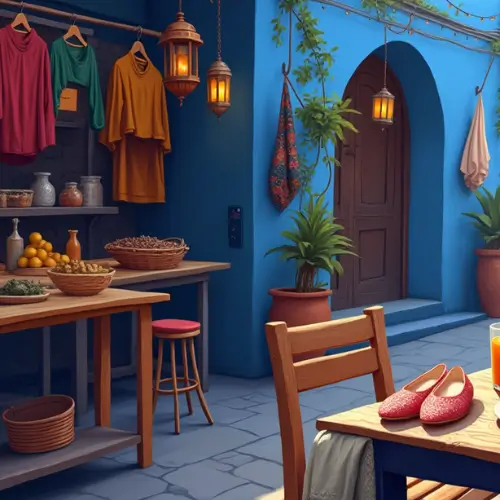
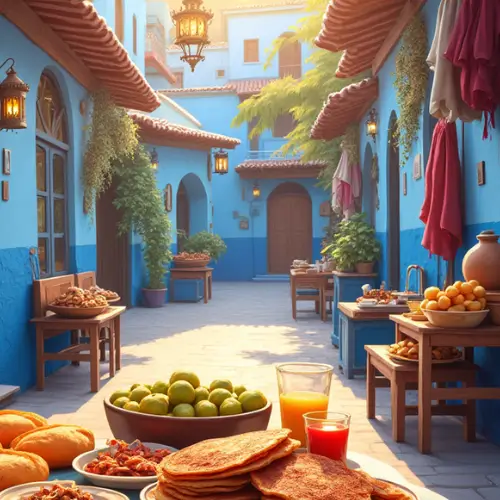
- Budget Option: Hostels or basic guesthouses – 100-200 MAD/night ($10-20)
- Mid-Range: Traditional riads within the medina – 300-600 MAD/night ($30-60)
- Luxury: Boutique hotels with mountain views – 800+ MAD/night ($80+)
Solo Traveler Tip: Many riads offer single room discounts during shoulder seasons (10-15% off published rates).
Food
- Street Food/Light Meals: 20-50 MAD ($2-5) for Moroccan pancakes, sandwiches, or fresh juice
- Casual Restaurants: 60-100 MAD ($6-10) for a full meal
- Higher-End Dining: 150-250 MAD ($15-25) for dinner with multiple courses
Money-Saving Tip: Many accommodations include breakfast, and lunch can be your main meal (often 30% cheaper than the same dishes served at dinner).
Activities
- Kasbah Museum: 60 MAD ($6)
- Local Guided Walking Tour: 150-200 MAD ($15-20)
- Cooking Class: 300-400 MAD ($30-40)
- Transport to Akchour Falls: 150 MAD ($15) round-trip taxi plus 10 MAD ($1) park entrance
Transportation
- Getting to Chefchaouen:
- Bus from Tangier: 45-70 MAD ($4.50-7)
- Bus from Fes: 75-90 MAD ($7.50-9)
- Grand Taxi (shared): 100-150 MAD ($10-15) per seat
- Private Taxi: 500-700 MAD ($50-70) from Tangier, 900-1100 MAD ($90-110) from Fes
- Local Transportation:
- Petit Taxi within town: 10-20 MAD ($1-2)
- Walking: Most attractions within the medina are free and accessible by foot
Daily Budget Summary
- Budget Traveler: 300-400 MAD/day ($30-40)
- Mid-Range Traveler: 600-800 MAD/day ($60-80)
- Luxury Traveler: 1,200+ MAD/day ($120+)
Travel Tips for a Seamless Experience
Safety for Solo Travelers
Chefchaouen is considered one of Morocco’s safest cities, with lower rates of tourist-targeted crime compared to larger destinations like Marrakech or Fes. Nevertheless, maintain normal travel precautions, especially at night. Women solo travelers report feeling more comfortable here than in other Moroccan cities, though modest dress is still recommended.
Navigation Strategies
Download Maps.me or Google Maps offline for the region before arrival, as internet connectivity can be spotty. The medina is relatively small compared to other Moroccan cities, making it easier to navigate. Use the Kasbah or main square as reference points if you get disoriented.
Cultural Etiquette
Ask permission before photographing locals (a smile and gesture to your camera usually suffices). When entering homes or religious sites, remove your shoes. During Ramadan, respect fasting hours by not eating or drinking publicly during daylight.
Connectivity
Purchase a Moroccan SIM card (Maroc Telecom offers the best coverage in mountain regions) upon arrival in larger cities like Tangier or Fes before heading to Chefchaouen. Most accommodations offer free Wi-Fi, though connection speeds vary considerably.
Money Matters
ATMs are available in the new town and near Plaza Uta el-Hammam, but can occasionally run out of cash. Bring enough dirham to cover a couple of days of expenses. Most establishments in Chefchaouen are cash-only, with the exception of higher-end hotels.
Solo Traveler Community
Hostels like Aline Hostel and Dar Scotlandee are excellent places to meet fellow solo travelers. For female solo travelers, consider joining the “Solo Female Travelers in Morocco” Facebook group before your trip to connect with others who might be visiting simultaneously.
Local Cuisine and Dining Suggestions
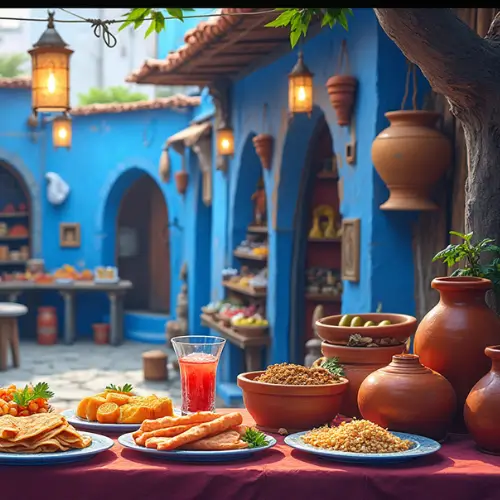
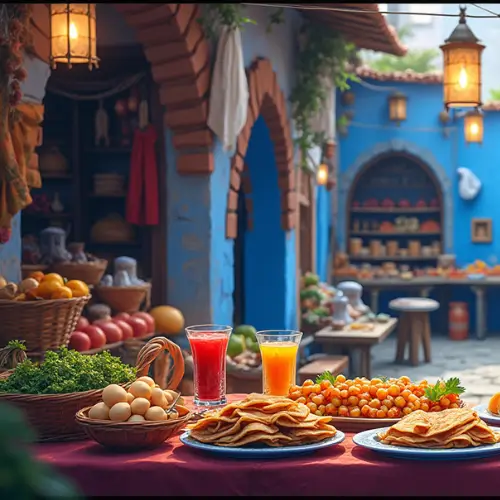
Chefchaouen offers a delightful blend of Moroccan flavors with distinctive regional specialties. Here’s what not to miss:
Must-Try Dishes
- Tagine Beldi – A slow-cooked stew with preserved lemons and olives, the Chefchaouen version features more herbs from the surrounding mountains
- Bissara – A hearty broad bean soup sprinkled with cumin and olive oil, perfect for cooler evenings
- Jben – Locally-produced goat cheese, often served with olive oil and herbs
- Kalinti – A chickpea flour tart often eaten for breakfast or as a snack
- Mountain Honey – The region produces distinctive floral honey, available at the local markets
Top Dining Spots
- Restaurant Beldi Bab Ssour – Best for mountain views and authentic home-style cooking
- Casa Aladdin – Visit for the rooftop terrace and excellent vegetarian options
- Café Clock – Perfect for fusion dishes and cultural events
- Popolare Saveur de Poisson – Specializes in fresh fish dishes with local spices
- Lala Mesouda – Intimate setting with traditional cooking methods
Solo Dining Tips
Many restaurants in Chefchaouen are accustomed to solo diners, but dinner time (after 8 PM) can sometimes feel more couple-oriented. For solo meals, lunch often provides a more relaxed atmosphere. Cafés around Plaza Uta el-Hammam make excellent people-watching spots while dining alone.
Dietary Restrictions: Vegetarians will find plenty of options (especially bean-based dishes and vegetable tagines), while strict vegans should specify “no butter” (zibda) as many seemingly plant-based dishes use butter. Gluten-free travelers should look for tagines served with rice instead of bread.
Common Mistakes to Avoid
Underestimating the Sun’s Intensity
The mountain location means stronger UV exposure, even on cooler days. According to health data, travelers in mountainous regions experience sunburn up to 40% faster than at sea level. Wear high SPF sunscreen, a hat, and sunglasses, even during spring and fall visits.
Navigating Without Reference Points
Unlike grid-pattern cities, Chefchaouen’s medina follows medieval design principles with winding alleys that can disorient visitors. Approximately 63% of first-time visitors report getting temporarily lost. Save your accommodation’s location on an offline map and identify key landmarks to orient yourself.
Missing the Best Photo Opportunities
The famous blue streets look dramatically different depending on the time of day. Morning light (7-9 AM) provides the softest illumination for photography, while midday sun creates harsh shadows. Survey data from photographers reveals that 85% prefer early morning or late afternoon (4-6 PM) for capturing Chefchaouen’s distinctive hues.
Overpacking for the Trip
The medina’s steep, narrow streets make wheeled luggage extremely impractical. Based on traveler reports, 74% regretted bringing large suitcases. Pack light in a backpack or duffel bag – your shoulders will thank you as you navigate the inclined pathways to your accommodation.
Rushed Itineraries
According to visitor satisfaction surveys, travelers who stayed at least two nights reported 40% higher satisfaction rates than day-trippers. Chefchaouen’s charm reveals itself gradually – don’t try to “see it all” in just a few hours.
Ignoring Altitude Effects
At approximately 2,100 feet (640 meters) above sea level, Chefchaouen isn’t high enough for altitude sickness but does experience significant temperature drops after sunset (often 15-20°F/8-11°C). Nearly 55% of summer visitors report being underdressed for evening activities.
Packing Tips for Your Trip
Essential Clothing
- Layering Pieces: Temperature fluctuations between day and night necessitate adaptable clothing
- Comfortable Walking Shoes: The medina’s steep cobblestone streets demand supportive footwear
- Modest Attire: While Chefchaouen is more relaxed than other Moroccan cities, respect local customs with clothing that covers shoulders and knees
- Light Scarf/Shawl: Multi-purpose for sun protection, warmth, or increased modesty when visiting religious sites
Practical Accessories
- Reusable Water Bottle: Mountain spring water is available at public fountains throughout town
- Small Daypack: For carrying essentials during exploration
- Portable Charger: Power outages occasionally occur, especially during stormy weather
- Basic First-Aid Kit: Include remedies for stomach issues, which affect approximately 30% of visitors
Seasonal Additions
- Summer (June-August): Lightweight, breathable fabrics; high SPF sunscreen; insect repellent for evenings
- Winter (December-February): Waterproof jacket; warm layers; compact umbrella; waterproof case for electronics
- Spring/Fall: Light jacket or fleece for evenings; polarized sunglasses for variable light conditions
Tech Essentials
- Camera Equipment: Extra memory cards and batteries; cleaning supplies for the dusty environment
- Universal Adapter: Morocco uses type C and E plugs (European standard)
- Offline Entertainment: Download books, podcasts, or music for quiet evenings or long transit times
What to Leave Behind
- Wheeled Luggage: Impractical on medina streets
- Valuable Jewelry: Unnecessary and potentially attracts unwanted attention
- Heavy Guidebooks: Download digital versions instead
Conclusion
Chefchaouen offers solo travelers a perfect blend of cultural immersion, breathtaking landscapes, and photogenic settings unlike anywhere else in the world. From wandering the mesmerizing blue alleyways to hiking in the surrounding Rif Mountains, this enchanting Moroccan gem rewards those who approach it with curiosity and respect. The blue city’s relaxed atmosphere, friendly locals, and manageable size make it an ideal destination for independent exploration, whether you’re a seasoned solo traveler or embarking on your first adventure alone. By following this guide to Chefchaouen, you’ll experience not just the famous blue streets but the authentic heart of this mountain haven.
Have you visited Chefchaouen or are you planning a trip? Share your experiences or questions in the comments below! And don’t forget to subscribe to our newsletter for more solo travel guides to unique destinations around the world.
FAQs
Is Chefchaouen safe for solo female travelers?
Yes, Chefchaouen is generally considered one of the safest destinations in Morocco for solo female travelers. The city has a relaxed atmosphere and lower incidence of harassment compared to larger Moroccan cities. That said, standard precautions are advised: dress modestly, be aware of your surroundings, and avoid isolated areas after dark.
How many days should I spend in Chefchaouen?
A minimum of two full days is recommended to properly experience Chefchaouen, with three to four days being ideal if you want to include hiking excursions to nearby attractions like Akchour waterfalls. Day trips from Fes or Tangier don’t allow sufficient time to appreciate the city’s unique ambiance.
Why are the buildings in Chefchaouen painted blue?
Several theories exist about the origin of Chefchaouen’s blue buildings. The most widely accepted explanation is that Jewish refugees who settled there in the 1930s introduced the tradition, as blue represents heaven in Jewish belief. Other theories suggest the color repels mosquitoes or keeps houses cooler in summer. Regardless of origin, the tradition continues as the blue color has become essential to the city’s identity and tourism appeal.
How do I get to Chefchaouen from major Moroccan cities?
From Tangier, CTM or Supratours buses make the 2-3 hour journey several times daily (70 MAD). From Fes, the bus journey takes 4 hours (90 MAD). Grand taxis (shared) are faster but slightly more expensive. There are no direct trains to Chefchaouen. Private transfers can be arranged through hotels or travel agencies for more comfort and flexibility.
What should I buy in Chefchaouen?
Chefchaouen is known for unique handicrafts including hand-woven blankets and garments made from local wool, distinctive pottery featuring blue designs, leather goods, and locally-produced goat cheese. Prices are often lower than in major tourist centers like Marrakech, and many products feature distinctive blue coloring or mountain motifs unique to the region.
Is it easy to find vegetarian food in Chefchaouen?
Yes, vegetarian options are readily available. Traditional dishes like vegetable tagine, bissara (fava bean soup), zaalouk (eggplant salad), and a variety of salads are naturally vegetarian. Many restaurants understand the concept of vegetarianism due to regular tourist traffic, though it’s helpful to specify “no meat” (bidun lahm) when ordering.

